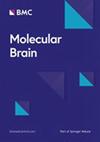癌症恶病质状态伴随下丘脑小胶质细胞极化与抑制性免疫检查点受体低表达的外周-中央网络分析
IF 3.3
3区 医学
Q2 NEUROSCIENCES
引用次数: 0
摘要
众所周知,癌症恶病质中的过度炎症是由外周炎症介质的过度产生所诱发的,而微生态破坏和大脑功能障碍也被认为是诱发癌症恶病质的原因之一。下丘脑小胶质细胞通过产生炎症介质,在脑部炎症和中枢-外周免疫回路中发挥着至关重要的作用。在本研究中,我们评估了移植胰腺癌细胞后癌症恶病质模型小鼠下丘脑小胶质细胞中肠道微生物群衍生内毒素过度分泌的可能变化以及几种炎症调节介质及其抑制调节剂的表达时间轴。我们发现,在肿瘤小鼠的晚期阶段,血浆中的脂多糖(LPS)水平显著升高,同时肠道中的厌氧菌(尤其是真菌)数量增加,这些小鼠表现出食欲急剧下降、肌肉疏松和严重的外周免疫抑制。在肿瘤小鼠尚未出现 "恶病质症状 "的早期阶段,促炎细胞因子的 mRNA 表达显著增加,但神经退行性和严重炎症调节因子脂钙蛋白-2(LCN2)的 mRNA 表达却没有增加、而在 "恶病质晚期",下丘脑小胶质细胞中 LCN2 mRNA 的水平明显升高,同时抑制性免疫检查点受体程序性死亡受体-1(PD-1)和 CD112R 的水平也明显下降。此外,还发现恶病质模型小鼠下丘脑室旁核(PVN)中活化神经元密度高,皮质酮分泌显著增加。与恶病质状态有关,正常小鼠释放的皮质酮在室旁核神经元的特异性激活下明显增加。在 PVN 神经元强激活的小鼠和癌症恶病质小鼠的脾脏中,也观察到自然杀伤细胞数量明显减少。另一方面,给正常小鼠体内注射 LPS 可诱导下丘脑小胶质细胞,但其抑制性免疫检查点受体的表达量较低。这些研究结果表明,在诱导癌症恶病质的同时,下丘脑的炎症状态也会加剧,肠道微生物释放 LPS 后,下丘脑小胶质细胞极化,并表达低水平的抑制性免疫检查点受体。本文章由计算机程序翻译,如有差异,请以英文原文为准。
Peripheral-central network analysis of cancer cachexia status accompanied by the polarization of hypothalamic microglia with low expression of inhibitory immune checkpoint receptors
While the excessive inflammation in cancer cachexia is well-known to be induced by the overproduction of inflammatory mediators in the periphery, microflora disruption and brain dysfunction are also considered to contribute to the induction of cancer cachexia. Hypothalamic microglia play a crucial role in brain inflammation and central-peripheral immune circuits via the production of inflammatory mediators. In the present study, we evaluated possible changes in excessive secretion of gut microbiota-derived endotoxin and the expression timeline of several inflammation-regulatory mediators and their inhibiting modulators in hypothalamic microglia of a mouse model of cancer cachexia following transplantation of pancreatic cancer cells. We demonstrated that the plasma level of lipopolysaccharide (LPS) was significantly increased with an increase in anaerobic bacteria, especially Firmicutes, in the gut at the late stage of tumor-bearing mice that exhibited dramatic appetite loss, sarcopenia and severe peripheral immune suppression. At the early stage, in which tumor-bearing mice had not yet displayed “cachexia symptoms”, the mRNA expression of pro-inflammatory cytokines, but not of the neurodegenerative and severe inflammatory modulator lipocalin-2 (LCN2), was significantly increased, whereas at the late “cachexia stage”, the level of LCN2 mRNA was significantly increased along with significant decreases in levels of inhibitory immune checkpoint receptors programmed death receptor-1 (PD-1) and CD112R in hypothalamic microglia. In addition, a high density of activated neurons in the paraventricular nucleus (PVN) of the hypothalamus region and a significant increase in corticosterone secretion were found in cachexia model mice. Related to the cachexia state, released corticosterone was clearly increased in normal mice with specific activation of PVN neurons. A marked decrease in the natural killer cell population was also observed in the spleen of mice with robust activation of PVN neurons as well as mice with cancer cachexia. On the other hand, in vivo administration of LPS in normal mice induced hypothalamic microglia with low expression of inhibitory immune checkpoint receptors. These findings suggest that the induction of cancer cachexia may parallel exacerbation of the hypothalamic inflammatory status with polarization to microglia expressed with low levels of inhibitory immune checkpoint receptors following LPS release from the gut microflora.
求助全文
通过发布文献求助,成功后即可免费获取论文全文。
去求助
来源期刊

Molecular Brain
NEUROSCIENCES-
CiteScore
7.30
自引率
0.00%
发文量
97
审稿时长
>12 weeks
期刊介绍:
Molecular Brain is an open access, peer-reviewed journal that considers manuscripts on all aspects of studies on the nervous system at the molecular, cellular, and systems level providing a forum for scientists to communicate their findings.
Molecular brain research is a rapidly expanding research field in which integrative approaches at the genetic, molecular, cellular and synaptic levels yield key information about the physiological and pathological brain. These studies involve the use of a wide range of modern techniques in molecular biology, genomics, proteomics, imaging and electrophysiology.
 求助内容:
求助内容: 应助结果提醒方式:
应助结果提醒方式:


